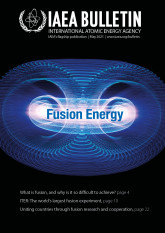
If you would like to learn more about the IAEA’s work, sign up for our weekly updates containing our most important news, multimedia and more.
ITER: The World's Largest Fusion Experiment
Wolfgang Picot

ITER construction site. (Photo: ITER)
ITER: The World's Largest Fusion Experiment
Weighing 23 000 tonnes and standing at nearly 30 metres tall, ITER will be an impressive sight to behold. This nuclear fusion reactor will sit at the heart of a 180-hectare site, together with auxiliary housing and equipment. The immense scale of ITER, Latin for “the way”, will considerably outsize the largest experimental fusion reactors currently in operation — the Joint European Torus (JET) in the United Kingdom and the joint European–Japanese JT-60SA in Japan.
But what is ITER’s potential, and, in an era of miniaturization and optimization, why is it necessary to build a research device on such a gigantic scale?
One of ITER’s primary goals is to prove that fusion reactions can produce significantly more energy than the energy supplied to initiate the reaction process — resulting in an overall gain in power. Reactors like ITER are called tokamaks, and use a combination of heating systems, strong magnets, and other devices to create energy-releasing fusion reactions in super-hot plasmas. The resulting magnetic fields bind and spin the charged particles around the doughnut-shaped reactor vessel so that these can fuse and produce fusion energy.
As for the question of size, larger tokamaks provide better insulation and confine the fusion particles for longer, thus producing more energy than smaller devices.
A significant indicator of a reactor’s performance is its fusion power gain, or the ratio between the fusion power produced and the power injected into the plasma to drive the reaction. It is expressed by the symbol ‘Q’.
To date, JET has achieved the best gain, with a Q value of 0.67, by producing 16 megawatts (MW) of fusion power from 24 MW of heating power. Much higher Q values will be needed for electricity production, however.
Prerequisites for power
Over the past 50 years of fusion experimentation, the performance of fusion devices has increased by a factor of 100 000, but a further increase by a factor of 5 is needed to arrive at the level of performance required for a power plant. To achieve this, researchers are working to optimize the plasma’s condition through changes in temperature, density and confinement time.
Some of these improvements have been the result of experimental fusion reactors becoming larger. With ITER’s height and radius being twice that of JET’s, its plasma volume will increase tenfold. Applying novel designs and innovative materials, ITER will also integrate some of the most powerful plasma-heating devices ever used. With the injection of just 50 MW heating power into the plasma, it aims to produce 500 MW of fusion power — giving a Q value of at least 10 — in pulses that are each roughly 5–10 minutes long.
ITER’s peak performance will be impressive, but it will only be reached for a very short amount of time. To become a steady source of electricity, future fusion power plants will need to operate continuously. A Q value of five represents a critical threshold, above which the plasma starts heating itself to sustain the fusion reaction on its own. To better understand how to achieve this self-sustaining reaction, ITER aims to eventually generate and maintain Q values of five for periods much longer than ten minutes.
A global collaboration
ITER’s 35 participating nations represent more than half of the world’s population and 85 per cent of global gross domestic product. While many other smaller fusion experiments are under way globally, most of them still coordinate, cooperate, or collaborate with the ITER Organization.
The IAEA and the ITER Organization have had a close relationship from the very beginning, particularly in the areas of nuclear fusion research, knowledge management, human resources development, and educational activities and outreach. The IAEA also helps the ITER Organization share their experiences in nuclear safety and radiation protection with IAEA Member States, including those not participating in the project. This year, the ITER Organization, together with the French Alternative Energies and Atomic Energy Commission (CEA), will co-host the IAEA Fusion Energy Conference.
It is hoped that ITER will prove the scientific and technological feasibility of fusion power production and, under its staged-approach research plan, will start conducting its first experiments in 2025. Full-power experiments should commence in 2035. If successful, these developments will be a significant milestone and will represent a historic bridge between experimental research and the first demonstration fusion power plants, or DEMOs. Envisioned DEMOs will achieve a net electrical energy gain. Multiple preliminary concepts for DEMO-type reactors are already under consideration. If everything goes according to plan, they could be in operation by mid-century.
Related stories
Related resources
- 28th IAEA Fusion Energy Conference (FEC 2020), 10-15 May 2021
- 28th IAEA Fusion Energy Conference (FEC 2020) Opening
- Fusion
- Fusion Energy for Peace and Sustainable Development
- Fusion FAQs
- Fusion Energy, IAEA Bulletin (Vol. 62/2, May 2021)
- Fusion Energy Conference 2018: Can We Harness the Energy that Powers the Sun?
- The Future of Fusion Energy






